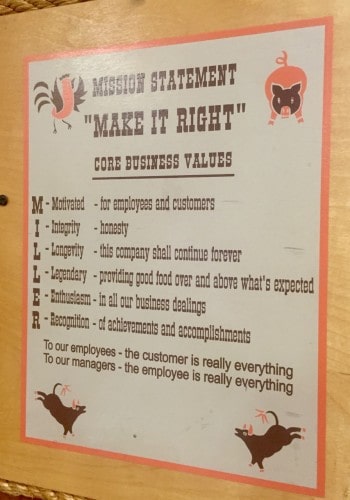I was back in San Antonio the other day (our move to Fort Worth is still an uncompleted process) and I went out for an early morning walk. That healthy behavior was followed by one slightly less healthy… breakfast at Bill Miller BBQ, a Texas restaurant chain that's been around since 1950. They're known for BBQ and fried chicken, mainly, along with breakfast tacos, hearty breakfasts, and giant refills of iced tea.
As my breakfast platter was being rung up, I saw this sign behind the register (and came back to discretely take a picture)… click for a larger view.
Sure, they have company values, such as motivated, integrity, longevity, legendary, enthusiasm, and recognition (that, of course, spells out Miller).
The bottom part of the sign seemed most meaningful to me (no, not the bucking bulls):
This message can apply in any business – retail, manufacturing, or healthcare. Take care of the employees, so they can take care of the customers (or patients).
It has to be, of course, more than just a poster or slogan on the wall. You need to live it. I hope Bill Miller does.
Managers also need, I'd say, to pay attention to systems and processes, but making the employee the focus goes a long way. This doesn't mean just being “nice,” but listening and engaging people, being a coach, respecting them and challenging them to do their best (while supporting their needs and being a servant leader to get there).
Rather than use so-called “just-in-time scheduling” practices that aren't really Lean, treat employees as partners, not a cost.
Does your organization do this? Do you like to support businesses that subscribe to this view?
What do you think? Please scroll down (or click) to post a comment. Or please share the post with your thoughts on LinkedIn – and follow me or connect with me there.
Did you like this post? Make sure you don't miss a post or podcast — Subscribe to get notified about posts via email daily or weekly.
Check out my latest book, The Mistakes That Make Us: Cultivating a Culture of Learning and Innovation:












I believe wholeheartedly in developing and investing in employees. Beyond respect for employees (and customers and suppliers) though, I have seen first-hand “Lean experts” on the shop floor promoted to the manager level where they are almost totally inept at doing this.
At the same time, there are many organizational models for growing, developing, and recognizing employees that are well documented. I know that Toyota has an approach to doing this, but is it just not well understood or are there significant organizational or cultural barriers that make this difficult?
Reminds me of the Cowboy Ethics; 1- Live each day with courage; 2- Take pride in your work; 3- Always finish what you start; 4- Do what has to be done; 5- Be tough, be fair; 6- When you make a promise keep it; 7- Ride for the brand; 8- Talk less and say more; 9- Remember that some things aren’t for sale; 10- Know where to draw the line.
When you don’t engage employees it just becomes a job. When it just becomes a job it’s just about showing up for the paycheck.
Great article! How were Bill Miller’s BBQ’s employees doing? Many companies post their company vision or core values on their website, but we can’t see their employees’ performance at the same time. On the other hand, it must be challenging for the restaurant managers when their customers can read their company values and see their employees’ performance right there in front of them. They have to “live it”, otherwise the sign will backfire.
The employees seemed to be doing OK. I’ll have to ask somebody about that sign sometime to see how they react. They might be totally unaware of the sign, even though it’s hanging right there… or it might be a meaningful part of their culture.
I hope it isn’t just a meaningless sign.
In the news:
Bill Miller BBQ standing behind employees during time of economic uncertainty